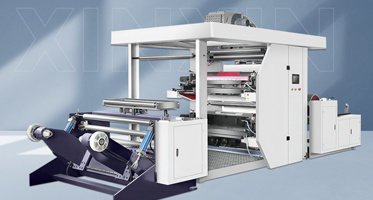20
2025
-
01
The Art of Precision: Unleashing the Capabilities of Flexographic Printing Machines
Author:
The Art of Precision: Unleashing the Capabilities of Flexographic Printing Machines
Table of Contents
- 1. Introduction to Flexographic Printing
- 2. A Brief History of Flexographic Printing
- 3. How Flexographic Printing Machines Work
- 4. Applications of Flexographic Printing
- 5. Advantages of Flexographic Printing Machines
- 6. Challenges in Flexographic Printing
- 7. The Future of Flexographic Printing Technology
- 8. Frequently Asked Questions (FAQs)
- 9. Conclusion
1. Introduction to Flexographic Printing
Flexographic printing is a revolutionary printing process that employs flexible relief plates to produce high-quality images on a variety of substrates. This method is particularly renowned for its speed and efficiency, making it a preferred choice in industries ranging from packaging to textiles. With the ever-evolving technology behind flexographic printing machines, businesses can achieve exceptional results with precision and consistency.
2. A Brief History of Flexographic Printing
The roots of flexographic printing trace back to the early 20th century when it was initially used for printing newspapers and other publications. As technology advanced, flexographic printing machines evolved to accommodate various inks and substrates, leading to their widespread adoption in packaging and label printing. By the 1980s, advancements in photopolymer plate technology and ink formulations significantly enhanced the quality and versatility of flexographic printing, solidifying its position in the printing industry.
3. How Flexographic Printing Machines Work
Flexographic printing operates on a straightforward principle. The process begins with the creation of flexible relief plates, which are typically made of photopolymer materials. These plates are mounted on rotating cylinders within the printing machine.
The Printing Process
1. **Ink Transfer**: A fountain roller supplies ink to the anilox roller, which transfers a controlled amount of ink to the plate.
2. **Plate Contact**: The plate cylinder comes into contact with the substrate, transferring the ink from the raised areas of the plate to the material.
3. **Drying Process**: After the ink is applied, the substrate passes through a drying unit, which can use heat or UV light to cure the ink, ensuring the final print is vibrant and smudge-free.
Types of Flexographic Printing Machines
Several types of flexographic printing machines exist, catering to different needs:
- **Central Impression (CI) Press**: This design features a central impression drum that allows for consistent ink transfer and print quality.
- **Stack Press**: This configuration stacks multiple printing units vertically, ideal for short runs and high-quality prints.
- **Inline Press**: Inline presses allow for integration of additional processes, such as die-cutting and laminating, in a single run, enhancing efficiency.
4. Applications of Flexographic Printing
Flexographic printing machines are versatile, finding applications in various industries, including:
- **Packaging**: From flexible pouches to corrugated boxes, flexography excels in producing high-quality packaging materials.
- **Label Printing**: Whether for food, beverage, or consumer products, flexographic machines deliver vibrant labels with intricate designs.
- **Textiles**: This printing method is extensively used for textiles, allowing for detailed patterns on fabrics.
- **Wall Coverings**: Flexographic printing is also employed in producing wallpaper and other decorative materials.
5. Advantages of Flexographic Printing Machines
The popularity of flexographic printing can be attributed to several key advantages:
- **Speed**: Flexographic machines operate at high speeds, significantly reducing turnaround times for large print runs.
- **Versatility**: This method accommodates a wide range of substrates, including plastic, paper, and metal.
- **Cost-Effectiveness**: The efficiency and speed of flexographic printing result in lower production costs, particularly for bulk orders.
- **Environmental Considerations**: With advancements in ink technology, many flexographic inks are now water-based, reducing volatile organic compounds (VOCs) and making the process more eco-friendly.
6. Challenges in Flexographic Printing
Despite its numerous advantages, flexographic printing does face some challenges:
- **Plate Wear**: Flexographic plates can wear out, leading to issues with print quality over time.
- **Registration Accuracy**: Achieving precise registration for multi-color prints can be challenging and requires careful calibration.
- **Initial Setup Costs**: While flexography is cost-effective for large runs, the initial investment in machinery and setup can be substantial for small businesses.
7. The Future of Flexographic Printing Technology
As technology continues to advance, the future of flexographic printing appears promising. Innovations such as digital flexography are emerging, combining the best aspects of traditional flexography with digital printing's flexibility. This hybrid approach allows for shorter runs and faster changeovers, catering to the growing demand for customization and quick turnaround times.
Furthermore, developments in sustainable practices are becoming increasingly prevalent in the flexographic printing industry. Manufacturers are focusing on reducing waste, improving ink formulations, and adopting eco-friendly substrates to meet consumer demand for sustainable packaging solutions.
8. Frequently Asked Questions (FAQs)
What types of substrates can be used in flexographic printing?
Flexographic printing can be used on a wide range of substrates, including paper, plastic films, cardboard, and metal foils.
How does flexographic printing compare to other printing methods?
Flexographic printing is known for its speed, versatility, and cost-effectiveness, particularly for large print runs, making it a preferred choice for packaging and labels compared to other methods like offset or gravure printing.
What are the environmental impacts of flexographic printing?
With advancements in water-based inks and sustainable practices, flexographic printing has become more environmentally friendly, reducing VOC emissions and waste.
How can I ensure high-quality prints with a flexographic printer?
To achieve high-quality prints, it's essential to maintain proper ink viscosity, ensure accurate registration, and regularly monitor plate wear.
What industries commonly use flexographic printing?
Flexographic printing is widely used in packaging, labels, textiles, wall coverings, and even in printing on various consumer goods.
9. Conclusion
Flexographic printing machines represent a remarkable evolution in the world of printing, combining speed, versatility, and cost-effectiveness to meet the needs of diverse industries. As technology continues to advance, the capabilities of these machines will only expand, offering even more innovative solutions for businesses. Understanding the intricacies of flexographic printing is essential for companies looking to harness its potential and achieve exceptional results in their printing endeavors. With a commitment to quality and efficiency, flexographic printing will remain a cornerstone of the modern printing landscape.
Related news
MESSAGE

Mobile website
Contact Us
Contacts:Alen Zhao
WeChat/Whatsapp:+ 86 18857712033
Mobile:+86 18857712033
E-mail:sales@xinxin-flexo.com
Add:No. 511, Development Zone Avenue, Ruian Economic Development Zone, Wenzhou City, Zhejiang Province, China
Fax:+86-577-65160712














